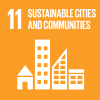
Average share of the built-up area of cities that is open space for public use for all, by sex, age and persons with disabilities
Last updated on 1 February 2022
This indicator is currently classified as Tier II. The United Nations Human Settlements Programme (UN-Habitat) is the Custodian agency for this indicator.
Unit of measure: Ratio of land allocated to public spaces and the total population with access to these spaces (%).
Why is this indicator important?
Cities work in a sustainable manner when private and public spaces have a symbiotic relationship. Public spaces are often seen as symbols of equality because they tend to be open and available to all members of the public regardless of sex, age, or disability. Yet these spaces have dwindled in urban areas in recent years.
Well-planned and managed public spaces have positive impacts, such as maintaining social inclusion, civic identity, quality of life, productivity, and environmental sustainability. However, the non-provision or privatization of public spaces has brought about increased exclusion and marginalization. City-wide policies and strategies should ensure proper planning, design and management of public spaces at different scales.
How is the indicator measured and monitored?
According to the metadata document, the area of public space is measured based on three steps: 1) spatial analysis to measure built-up areas that refer to urban/city area; 2) identification and estimation of the total area occupied by open public spaces and; 3) estimation of the total area allocated to streets. The data is disaggregated by quality of the open public space (in terms of safety, inclusivity, accessibility, greenness, and comfort), type of open space (e.g., green, blue) as well as age, gender, and disability status.
Most data is collected through urban land use plans, GIS data, or community mapping, in collaboration with national statistical authorities and other stakeholders working on this indicator. Existing data covers 712 cities with new cities being added constantly.
By Anne Hennings, peer-reviewed by Dennis Mwaniki, Spatial Data Expert at UN-Habitat’s Data and Analytics Unit.
Other related indicators on Land Portal
In addition to the official indicator data, the following indicators provide information on urban expansion and restrictions on urban land use and ownership.
| Indicator | Min-Max Number of years |
Countries / Obs | Min / Max Value |
|---|---|---|---|
| Process for urban expansion clear, public, respects rights | |||
| Restrictions on urban land use, ownership and transferability |
Paginação
- Previous page ‹ previous
- Page 6
Law on the use of public space (Public Space Law).
The present Law lays down provisions relating to the use of public space. In particular, the purpose of the Law is to conserve and develop public space as an attractive habitat for the Community.
Act No. 10 on the development of urban green spaces.
The aim of this Act is the promotion and development of green spaces in urban areas. The Municipalities shall be responsible for developing urban green spaces within their territories, whilst a special committee under the Ministry of the Environment shall exercise monitoring functions.
Paginação
![]()

By 2030, provide universal access to safe, inclusive and accessible, green and public spaces, in particular for women and children, older persons and persons with disabilities
Indicator details
The indicator is conceptually clear, has an internationally established methodology and standards are available, but data is not regularly produced by countries.
Key dates:


